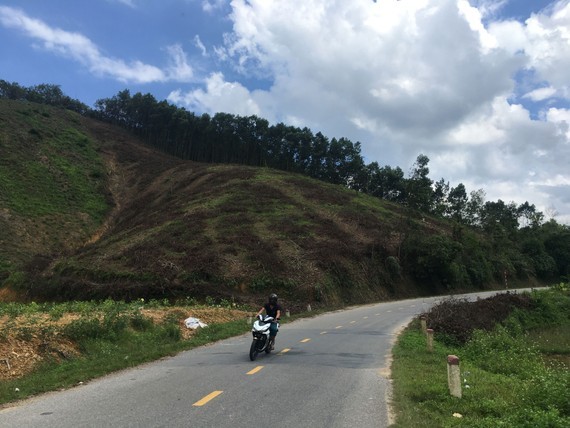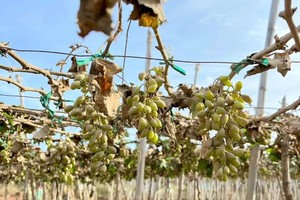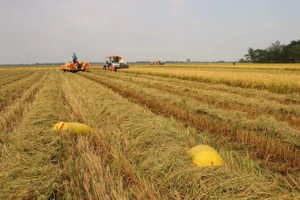 A patch of acacia plantation forest in Kim Boi District in Hoa Binh Province is exploited early. (Photo: SGGP)
A patch of acacia plantation forest in Kim Boi District in Hoa Binh Province is exploited early. (Photo: SGGP)
In the past 3-4 months, in many localities, such as Hoa Binh, Phu Tho, Yen Bai, Lao Cai, Quang Ngai, and some provinces in Central Vietnam, plantation forest owners have rushed to exploit and sell acacia trees early because of high prices. In Luong Son, Lac Thuy, and Kim Boi districts of Hoa Binh Province, in the past 1-2 months, trucks carrying acacia logs have been rushing back and forth as each patch of acacia plantation forest has been chopped down, and loggers have been busy working at full capacity. A plantation forest owner in Du Sang Commune in Kim Boi District said that, normally, the acacia harvesting season is at the beginning of the year, but, up to now, many places are still exploiting acacia forest. At the end of 2021, a ton of 6-7-year-old acacia trees was sold for only VND900,000. However, currently, the price of acacia trees has surged to VND1.1 million-VND1.2 million per ton. According to enterprises collecting acacia woodchips in Quang Ngai Province, the price of a ton of acacia woodchips has reached VND1.5 million. On average, each hectare of acacia trees, which only brought in about VND70-80 million previously, is now raked in over VND100 million, or even VND200 million in some places, depending on the age of the acacia trees. However, according to Mr. Nguyen Van Dien, Director of the Forestry Production Management Department at the Vietnam Administration of Forestry under the Ministry of Agriculture and Rural Development, due to the sharp increase in woodchip prices, plantation forests in many places are at risk of being exploited early. Normally, acacia trees are grown from 6-7 years to 10 years before they can be exploited for high productivity and economic efficiency. However, people in many places are cutting down 3-4-year-old acacia trees, so the wood output is not high. The reason is that due to the influence of the war between Russia and Ukraine, countries are short of woodchips, so they have increased imports. Mr. Nguyen Van Dien added that at the beginning of this year, the export price of woodchips was only US$130 per ton, but it has skyrocketed to $180 per ton. In Vietnam, woodchips are mainly made from acacia wood, so enterprises have been increasing purchasing and exporting to China. “Although the export price of woodchips is high, it is not good news to us,” said Mr. Nguyen Van Dien. He explained that the situation of plantation forest owners rushed to sell young wood would affect the strategy of large timber plantations. Many enterprises have requested the Ministry of Agriculture and Rural Development and the Ministry of Industry and Trade to have orientations and solutions to control this situation. Particularly, it is necessary to set out criteria for harvesting timber from production forests to avoid the situation of exploiting young timber. Director General of the Vietnam Administration of Forestry Nguyen Quoc Tri said that production forests had been assigned to forest owners, so forest management and exploitation are the rights of the forest owners, who decide and are responsible for their decisions. "When the forest is harvested is decided by the forest owners," said Mr. Nguyen Quoc Tri, and affirmed that State management agencies cannot prohibit people from exploiting. According to Mr. Nguyen Quoc Tri, the war between Russia and Ukraine has caused a shortage of wood materials and increased inflation in the world. It is a difficulty but also an opportunity. The Ministry of Agriculture and Rural Development and localities can only recommend that young trees should not be cut because it affects the productivity and value of timber and, at the same time, encourage people to prioritize growing large timber forests.
According to the Vietnam Administration of Forestry, in the first six months of 2022, the export of wood and forest products reached $9.1 billion, up 3 percent over the same period in 2021. The trade surplus topped nearly $7.51 billion, up 3 percent over the same period. The main export markets of Vietnam's wood and forest products include the US, Japan, China, the EU, and South Korea. Timber output from concentrated plantation forests is about 8.5 million cubic meters, reaching 46 percent of the plan, up 5.9 percent over the same period in 2021.
























